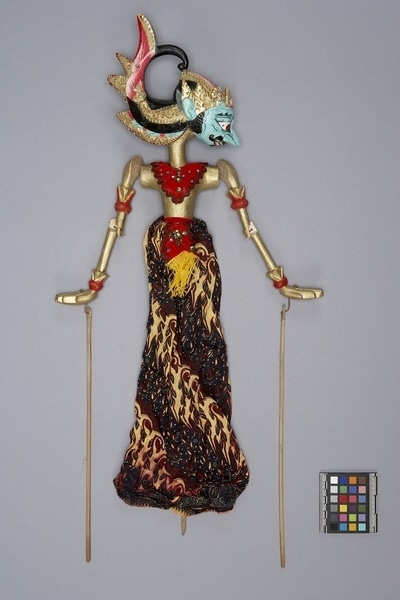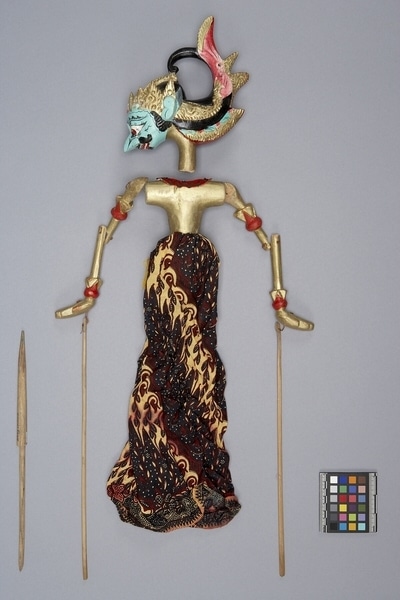Rod Puppet Item Number: Ib401 a-c from the MOA: University of British Columbia


Description
Three-dimensional male humanoid puppet: large head (part b) fits into body with skirt (part a), and a control rod (part c) with a long shaft that passes through the body and fits into the neck of the figure's head. The body has jointed arms, each with a long controlling rod attached. Head positioned downwards; green face with exaggerated features: bulging white eyes, red irises, large wedge-shaped nose, red lips, and white teeth. Thick moustache with small beard, other details in black. Black gelung supit urang headdress with Garuda Mungkur in pink and red. Neck, upper torso gold; pair of gold and red ornaments on each arm at bicep and wrist. Hands held flat and bent back at wrist. Red chest covering and apron with green and blue sequins, beads, brown trim. Apron with red waistband and yellow fringe at bottom. Purple, blue and beige batik skirt.
History Of Use
Javanese puppetry as an art form probably developed by the 11th century. Wayang golek puppets of western Java appeared during the 16th century. Originally the plays depicted Javanese mythology, but after the Indian conquest of Java the Hindu epics, Ramayana and Mahabharata, were incorporated into the cycles, which comprise about 200 plays. A dalang (puppet master) performs the plays to celebrate important occasions, usually in three acts, with vocal and instrumental accompaniment. Typically they serve a moral and religious purpose, and more recently, one of political commentary. Gatot Kaca is a very old and popular character, son of Bima (whom he resembles) with whom he shares the ability of flight. Both appear in the Mahabharata cycle.
Cultural Context
Theatrical performance.
Iconographic Meaning
Each puppet is characterized by its wanda, a Javanese word which describes the specific mixture of elements of size, form, colour, ornamentation and carving. Facial colour suggest maturity or spiritual calmness. Large facial features, and red eyes are unrefined. Batik skirt, position of hands, and particularly headdress indicate nobility, if not high virtue. Character identified as Gatot Kaca, although headdress is slightly less complex.
Item History
- Made in Java, Indonesia
- Owned by Donald Bone before January 4, 1980
- Received from Donald Bone (Seller) and Museum of Anthropology Donations Fund (Funding source) on January 4, 1980
What
- Name
- Rod Puppet
- Identification Number
- Ib401 a-c
- Type of Item
- puppet
- Material
- paint, fibre, wood and cotton fibre
- Manufacturing Technique
- tied, woven, sewn, painted and carved
- Part A
- height 58.0 cm, width 18.0 cm, depth 6.3 cm
- Part B
- height 21.0 cm, width 8.5 cm, depth 17.5 cm
- Part C
- height 33.0 cm, diameter 1.4 cm
Who
- Culture
- Sundanese
- Previous Owner
- Donald Bone
- Received from
- Donald Bone (Seller) and Museum of Anthropology Donations Fund (Funding source)
Where
- Holding Institution
- MOA: University of British Columbia
- Made in
- Java, Indonesia
When
- Ownership Date
- before January 4, 1980
- Acquisition Date
- on January 4, 1980
Other
- Condition
- fair
- Accession Number
- 0586/0021 a-c